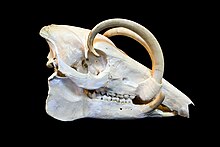Babirusa: Difference between revisions
m Reverted edits by 66.210.114.195 (talk) to last revision by Archaeodontosaurus (HG) |
|||
| Line 35: | Line 35: | ||
===Reproduction=== |
===Reproduction=== |
||
In the north Sulawesi |
In the north Sulawesi babirusahello kevin scanchez, males "[[boxing|box]]" much like [[rabbit]]s or [[kangaroo]]s during mating season. Females after 120–150 days have a [[Litter (animal)|litter]] of one or two [[piglet]]s, in a [[nest]]. Little is known about the behavior of the other species of babirusas, but it may match that of the north Sulawesi babirusa. |
||
==Notable characteristics== |
==Notable characteristics== |
||
Revision as of 15:48, 25 October 2010
| Babirusa | |
|---|---|

| |
| Babyrousa celebensis | |
| Scientific classification | |
| Kingdom: | |
| Phylum: | |
| Class: | |
| Superorder: | |
| Order: | |
| Family: | |
| Subfamily: | Babyrousinae
|
| Genus: | Babyrousa Perry, 1811
|
| Species | |
|
See text. | |
The babirusas are a genus, Babyrousa, in the pig family (Suidae) found in Wallacea, or specifically the Indonesian islands of Sulawesi, Togian, Sula and Buru.[1] All members of this genus were considered part of a single species until recently, the babirusa, B. babyrussa, but following the split into several species, this scientific name is restricted to the Buru babirusa from Buru and Sula, whereas the best-known species, the north Sulawesi babirusa, is named B. celebensis.[2] The name "pig-deer" has sometimes also been used in English, and is a direct translation of the Indonesian babi-rusa.
Classification
The genus is monotypic within the subfamily Babyrousinae, or alternatively considered to form a tribe, Babyrousini, of the subfamily Suinae.
All members of this genus were considered part of a single species until recently, the babirusa or pig-deer, B. babyrussa, but following the split into several species, this scientific name is restricted to the Buru babirusa from Buru and the Sula Islands, whereas the best-known species, the north Sulawesi babirusa, is named B. celebensis.[2] The split, which uses the phylogenetic species concept, is based on differences in size, amount of hair on body and tail-tuft, and measurements of the skull and teeth.[2]
Origin
Although babirusas are present on both Sulawesi and Sula, they are not found on the large islands between the two, the Banggai Archipelago. It has been hypothesized the unusual distribution is due to them being transported by humans as gifts bestowed by native royalty.[3]
The Balinese Hindu-era Court of Justice pavilion and the "floating pavilion" of Klungkung palace ruins are notable for painted babirusa raksasa (gargoyles) on the ceilings.[3]
To date, only one fossil skull has been found to suggest a larger ancestor.[4]
Habitat and behavior
The babirusas are found in tropical forest. They are omnivores, but mainly feed on fruits.[5]
Reproduction
In the north Sulawesi babirusahello kevin scanchez, males "box" much like rabbits or kangaroos during mating season. Females after 120–150 days have a litter of one or two piglets, in a nest. Little is known about the behavior of the other species of babirusas, but it may match that of the north Sulawesi babirusa.
Notable characteristics

The male has highly conspicuous tusks formed from the canine teeth, but their exact shape depends on the species. In the north Sulawesi babirusa, they grow upward through the skull and curve back towards the skull between the eyes, while they lack the strong curve in the Togian babirusa.[2] Both the north Sulawesi and Togian babirusa are nearly bald (with only very fine hairs), but the latter has a relatively distinct tail-tuft. As also suggested by the alternative names for the Buru babirusa, hairy or golden babirusa, it is covered in relatively dense golden hair, resulting in a rather different appearance than the other species.[2]
The female has only one pair of teats.[5]
Status
The babirusas are protected in Indonesia and poaching is illegal. Yet, a large percent of the inhabitants of Sulawesi and surrounding islands are Christians (in a country otherwise predominantly Muslim), and hunting and pork are major components of their diet and culture. The babirusa is thus considered something of a delicacy. All extant species of babirusa are threatened by hunting and habitat destruction, resulting in them being listed as vulnerable or endangered by the IUCN.[6]
Babyrousa babyrussa beruensis was described as an extinct, Pleistocene subspecies from southwestern Sulawesi before babirusas were split into multiple species.
Species
- Buru babirusa (Babyrousa babyrussa), also known as the hairy or golden babirusa.
- Bola Batu babirusa (Babyrousa bolabatuensis)
- North Sulawesi babirusa (Babyrousa celebensis), also known as the Sulawesi babirusa.
- Togian babirusa (Babyrousa togeanensis)
References
- ^ Wilson, D. E.; Reeder, D. M., eds. (2005). Mammal Species of the World: A Taxonomic and Geographic Reference (3rd ed.). Johns Hopkins University Press. ISBN 978-0-8018-8221-0. OCLC 62265494.
- ^ a b c d e Meijaard, E., & C. Groves. (2002). Proposal for taxonomic changes within the genus Babyrousa. Asian Wild Pig News 2 (1), 9-10.
- ^ a b Umberto Albarella, Keith Dobney, Anton Ervynck: 2007. Pigs and humans: 10,000 years of interaction Oxford University Press 2007. ISBN 9780199207046. 454 pages: pp20.
- ^ Ian Metcalfe, Faunal and floral migrations and evolution in SE Asia-AustralasiaCRC Press, 2001. ISBN 9789058093493. 416 pages: pp338.
- ^ a b BBC (2010). Babirusa. Downloaded 18 April 2010.
- ^ IUCN 2010. IUCN Red List of Threatened Species. Version 2010.1. Downloaded 18 April 2010.
